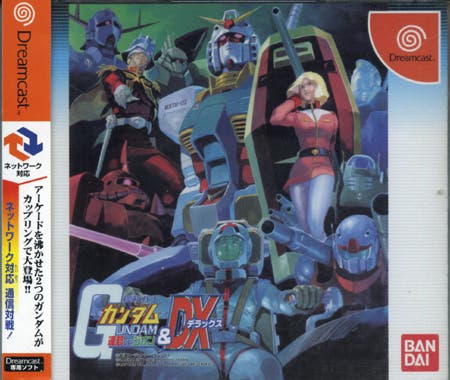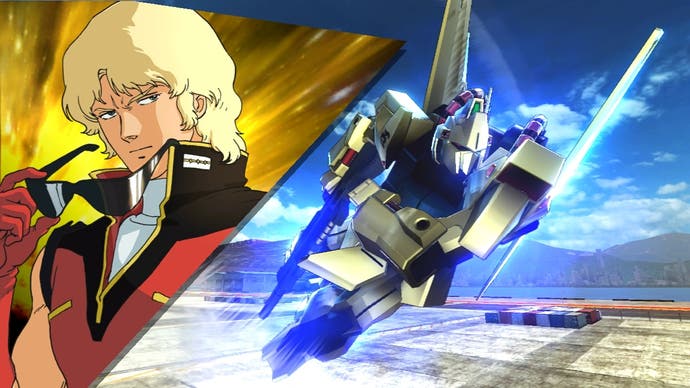What's behind Japan's Gundam game obsession?
A look behind the games and the culture that have consumed Japanese arcades.
One of the most remarkable aspects about the Japanese arcade scene is that it still exists. Perhaps it's because organised criminals loves to launder their money through arcades and pachinko parlours, or perhaps it's just down to the reality that people still want to play games there.
More so than online gaming, arcade multiplayer is an intimate, rewarding experience. People are civil, you don't have to contend with input lag - if you mess up it's your fault, and not that of dodgy net code, and when things do go awry players are less likely to let off strings of expletives in public. Thanks to this intimacy, groups of players congregate into little communities. On a purely anthropological level, it's actually rather fascinating.
The games and communities that endure are almost always those that have a solid multiplayer game at their centre. Traditionally these focal points of interest were the classic beat 'em-ups of old - your Street Fighters or your King of Fighters - but over the last decade or so a new entry has managed to create similar fervor.

In 2001, Capcom teamed up with Bandai to bring the mighty Mobile Suit Gundam to the Japanese arcades as an arena versus game. At the time it was a huge deal - after all who knows better about arcade multiplayer games than Capcom? Not to mention that this was nothing less than Gundam getting the full on Capcom treatment.
To give you some kind of idea how important Gundam is in Japan and through most of Asia, imagine Star Wars had babies with Star Trek. Then imagine that in turn created a sprawling trans-media empire with an 18 metre life-size replica towering over its excitable fan base. To say that Gundam dwarfs most of its global competition is both a figurative and literal truth.
Much of this fascination with the Gundam mythos stems back to the original TV series and compilation movie trilogy. Whilst primarily about a space-based civil war, in amidst the flak was some of exquisite characterisation and writing. The mecha were just along for the ride - and, if anything, their toy and model kit popularity has more to do with the characters they represent than the designs themselves.
So when Capcom landed the deal to do the first Gundam Versus game, entitled Renpou vs Zeon, everybody went suitably crazy.
Capcom's Gundam games arrived at a time when another mecha versus game dominated the scene, the once mighty Virtual On from Sega. By the time Renpou vs Zeon hit the arcades back in 2001 the third entry in the Virtual On series, Virtual On Force, had already been announced and boasted the introduction of new four player versus. Capcom had to follow suit.
When Renpou vs Zeon hit the arcades it kept to the vogue of four player versus - but sadly it wasn't all that great. After the intricate ballet of fixed vectored dash attacks seen in the Virtual On series, the simple orbit lock-on combat seen in Renpou vs Zeon didn't really cut it. It had its followers, for sure, but the Gundam Versus series started off with a whimper. That was, however, to be addressed by the console ports.

The success of home versions convinced Bandai to keep on supporting the series, and in doing so allowed the arcade community to steadily grow around the games. Sega's increasing ability in dropping the ball only helped matters: Virtual On was sidelined, leaving the growing Gundam Versus fan base to pick up the pieces.
In time, the games shifted away from the original simple orbit lock-on setup and became increasingly more involved. New dashing mechanics were introduced, and then something crazy happened. Up to this point, Gundam Versus games was limited to a single series - so each unit was from a specific show or set of films. But soon the entire universe was to be thrown together.
Catchily titled "Gundam vs Gundam", it featured the main protagonist and antagonist mobile suits from every major series and film in the Gundam pantheon. It was the "force multiplier" that catapulted the a niche arcade series into the serious arcade limelight in Japan.
The success hasn't shown any signs of slowing, bolstered in recent years by the Gundam Extreme Versus series which now dominate Japanese arcades. Originally developed by former Capcom and Bandai staff under a new studio called Byking (they also made the suitably off kilter Gunslinger Stratos as well), the Extreme Versus games are some of the best, most intricate arcade brawlers out there.
Ironically, with their fastidious focus on tactical dashing they play like the spiritual successors to Sega's Virtual On games,. In that you can wrong foot opponents by timing your attacks with their animation freeze at the end of a dash. That may sound straightforward, but the Extreme Versus games are aptly named - they are blindingly fast.

So much so that the staple melee combat now has on the fly input cancelling that resolves to a new feint manoeuvre. This produces a rainbow hue when done successfully and is used to turn the tables on close combat eager opponents. The rainbow cancel, with its flair and its spectacle, is the quintessential Gundam game mechanic.
As the characters are what make up Gundam's foundation for success, a subset of these are known as Newtypes. These are effectively the next stage of human evolution brought about by humanity starting to live in space. Once placed inside a mobile suit they can instantly ascertain how to operate it and, critically, tell when an opponent is going to attack.
In short, Byking distilled one of those most revered pillars of the Gundam mythos, pre-cognizant Newtypes, into a very handy close combat mechanic. It's rare to see Gundam handled properly in gaming form, but Byking totally nailed it. As such it is now not uncommon to see rows of the latest iteration of the Extreme Versus game in most Japanese arcades.
These days Byking are no longer involved and the newer entries are handled by Bandai's in-house team, but this hasn't harmed the quality at all. If anything, the games are becoming more and more popular.
Still, since the series' inception back in 2001 it has come a long way and garnered the respect - and 100 yen coins - of legions of Japanese arcade goers. Gundam fans and gamers alike flock daily to pit mobile suit against mobile suit, and that's still a wonderful thing to behold.
